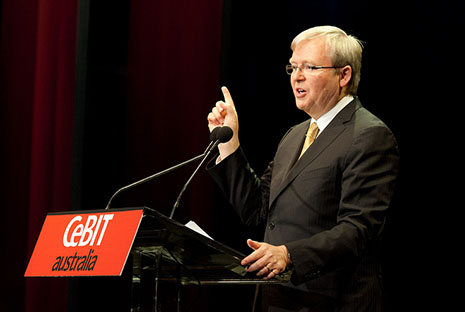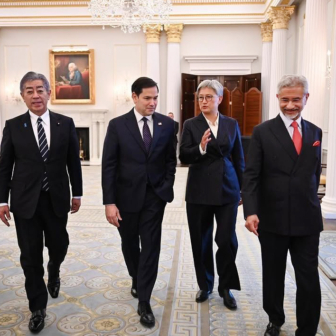Middle Power Dreaming: Australia in World Affairs, 2006–2010
Edited by James Cotton and John Ravenhill | Oxford University Press | $97.95
BOOKS on Australian foreign policy seldom have inspired titles. Credit then to Middle Power Dreaming, a clever title that reaches towards the poetic. This may be the best moniker anyone has dreamed up for a work on that minority sport, Australian international relations.
The title begins with Australia’s diplomatic and economic aspirations to be an active and engaged middle power on the international stage. The brilliance is in the Dreaming, invoking the Aboriginal idea of all that is known, understood and told to each generation. Together, they conjure up a distinct Australian way of looking at the world. And you can add to this another important layer of meaning running through the book – a sense that nightmares can lurk within these dreams.
Dreaming contains sixteen essays and is the eleventh volume in a series, stretching back to 1950, sponsored by the Australian Institute of International Affairs. My long membership of the institute makes me a biased witness, but the very longevity of the series offers support for the claim that it is an impressive and unique contribution to the recording and understanding of Australian foreign policy.
In telling the story of Australia in world affairs from 2006 to 2010, Dreaming lays out the understandings, the dreams and the dark possibilities of an Asian Century marked by fundamental shifts in power. The book captures a five-year period while simultaneously describing longer-term trends.
For the fourth time, the joint editors are Professor James Cotton and Professor John Ravenhill. This is a balanced partnership: two sharp intelligences, seasoned by Ravenhill’s wry eye and Cotton’s dry humour. They have achieved some coherence in a volume that describes three governments – John Howard’s final term, Kevin Rudd until June 2010, and the early days of Julia Gillard’s administration – and offer chapters dealing with Australia’s relations with the United States, China, Japan, Europe, South Asia, the Pacific Islands, Southeast Asia and Africa, with the challenges of “environmental foreign policy,” and with Kevin Rudd’s 2020 Summit as an experiment in making foreign policy.
A joint essay by Cotton and Ravenhill opens the collection. They describe the elements of Australia’s “middle power” effort, arguing that it is more than simply a matter of size but also denotes the nation’s ambition, capability and credibility. Using these measures, they award Australia low marks, judging that during those five years, “Australian policy-makers may have dreamed of assuming a middle power role on the world stage, but they were destined to play a minor part, a character torn between a realist mien and more noble impulses.”
The second chapter, by the distinguished journalist Geoffrey Barker, surveys the character and legacy of John Howard’s prime ministership. In typical style – astute and acerbic – Barker tracks how Australia’s second-longest-serving leader used the tactics perfected by the longest-serving, Robert Menzies, to politicise aspects of foreign and security policy for domestic political purposes. The Barker acid is leavened by appreciation for a political master: “While Howard liked to project himself as a warrior prime minister, he was a complex and calculating warrior, capable of flexibility and subtlety. His conduct of foreign policy was at once conservative, conventional, populist and realist.”
With his foreign minister, Alexander Downer, Howard called for a foreign policy based on a hard-headed pursuit of interests, seeking practical outcomes rather than pursuing grand theories. Barker pronounces this “the foreign policy of a wealthy and cocksure provincial power.” Titled “Global Deputy, Regional Sheriff,” the chapter concludes that Howard and Downer positioned Australia as “an uncritically loyal appendage, a ‘deputy sheriff,’ to the United States – a phrase that Howard detested after effectively assenting to it during an interview.”
In his chapter on Australia and the United States, Cotton notes that one of the last acts of President George W. Bush was to invest Howard with the Congressional Medal of Freedom. Cotton points out, however, that despite the claims about a close partnership between the two men, Howard “only appeared three times” in the Bush memoirs.
Such evidence can be an unreliable guide. Paul Keating worked closely with Bill Clinton in the late 1980s and early 90s to establish the Asia-Pacific Economic Cooperation summit, but doesn’t appear once in Clinton’s autobiography. Howard, by contrast, pops up twice in the Clinton book, and three mentions from Bush means that Howard has lifted his score.
Whatever their many differences of personality and policy, Howard, Rudd and Gillard have been as one in their devotion to the American alliance. Cotton, though, detects signs that Australia’s elite is reassessing American power and whether Australia can rely on the US security guarantee.
In similar fashion, Jian Zhang finds paradoxes in the effort by Australia and China to forge a true friendship. “While the relationship grew deeper, became more broadly based and assumed unprecedented prominence for both countries,” he writes, “it also became exceedingly complicated, controversial and difficult to manage.”
The future of US power and the complexities of China’s growing power – and particularly “the likelihood of major destabilising changes” – drive Hugh White’s account of defence policy. He writes that the Rudd government’s defence white paper, released in 2009, could not reach a clear conclusion about the fundamental questions raised by China’s rise and was “ambivalent about China’s intentions and the legitimacy of its growing military capability.” According to White, a former deputy secretary of the Defence Department, strategic and defence policy drifted during the five years as power shifted in Asia. Defence was preoccupied with Iraq and Afghanistan, and little was done to fix the “deep systemic problems” within the department.
AND what of diplomacy? In musing on Australia’s middle power aspirations, Cotton and Ravenhill argue that the instruments of diplomacy were seriously neglected during the Howard–Downer period and that this continued under Rudd. They describe it as “a little ironic” that after Rudd was shunted from being leader to become foreign minister he started to lament the lack of resources available to the Department of Foreign Affairs and Trade, or DFAT. In a speech in 2010 to mark the seventy-fifth anniversary of the department’s establishment, Rudd acknowledged that failure: “The truth is DFAT was starved for a decade... I am acutely conscious of a core fact: we now have 18 per cent fewer staff abroad than we did in 1996, while in the rest of the Australian Public Service there are now 12 per cent more staff.”
In his chapter, Michael Wesley tracks this “slow withering” in the resources, staffing and policy creativity of DFAT. He identifies three broad forces that saw DFAT lose its supremacy over Australia’s foreign policy: the overwhelming of the foreign policy machinery by the logic and demands of national security; the expansion of the foreign policy community to include a broad swathe of government agencies; and the slow institutionalisation of a presidential system centred on the prime minister.
One of John Howard’s most significant and enduring contributions was his creation of the National Security Committee of cabinet. An important element of the innovation was the regular attendance and participation of secretaries and agency heads from the Prime Minister’s Department, DFAT, Defence, the Defence Force, ASIO, the Office of National Assessments, and the Australian Federal Police. As Wesley notes, “Never before in Australian government has a prime minister had such regular and unmediated access to agency heads, and never had the prime minister’s policy deliberations with his ministers been so augmented by the views and direct advice of the heads of those ministers’ departments.”
The formal line is that the officials took part in discussions while only ministers made the decisions, but this presidential system remade the way Australia’s leaders and bureaucrats debate and do policy. Wesley concludes that the changes made by Howard and adopted by Rudd effectively joined up foreign policy and security agencies, but that “the growing dominance of national security over foreign policy risks mortgaging Australia’s international policy to narrow national security considerations.”
THROUGH the collective effect of its separate essays, Dreaming stands as the equal to the ten previous volumes in the series. And the title easily passes the Clive James test: book titles may not be a “true study, but they are a lasting interest” and a first clue to the sensibility of the writer.
To judge whether Middle Power Dreaming is the best-ever title for a book on Australian foreign policy, I asked some gurus for their list of great titles (rather than best book). The eventual field: Coral Bell’s Dependent Ally; Richard Casey’s Friends and Neighbours; Alan Renouf’s The Frightened Country; Malcolm Booker’s The Last Domino; Rawdon Dalrymple’s Continental Drift; Greg Sheridan’s Living with Dragons; Alison Broinowski’s About Face: Asian Accounts of Australia; Christopher Waters’s The Empire Fractures; Gregory Pemberton’s All the Way: Australia’s Road to Vietnam; and Richard Woolcott’s The Hot Seat: Reflections on Diplomacy.
Because of the multiple layers it conveys and its almost poetic effect, Middle Power Dreaming beats them all as a title, elegantly capturing the essences of a complex work in three words. •




